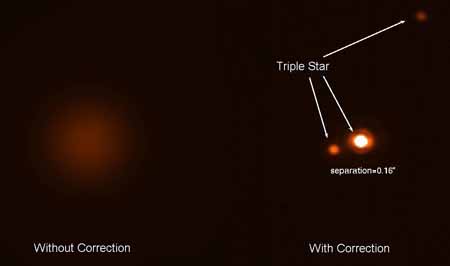Sharper than Hubble: Large Binocular Telescope achieves major breakthrough
18 June 2010
Max Planck Society

A double star as observed with the LBT in standard mode (left), and with the adaptive correction activated (right). Because of atmospheric blurring, the fainter companion of the star cannot be identified in the images taken in standard mode, while it is easily visible when the adaptive module is activated. A third faint star also becomes visible in the upper right part of the frame, thanks to the increased sensitivity of the telescope in adaptive mode. (Image: LBT Collaboration)
The next generation of adaptive optics has arrived at the Large Binocular Telescope (LBT) in Arizona, providing astronomers with a new level of image sharpness never before seen. Developed in a collaboration between Italy's Arcetri Observatory of the Istituto Nazionale di Astrofisica (INAF) and the University of Arizona's Steward Observatory, this technology represents a remarkable step forward for astronomy.
The LBT, with its two 8.4-meter mirrors, is the largest single optical telescope in the world. The telescope is a collaboration between institutions from the USA, Italy and Germany. Germany's 25% participation is represented by the Max-Planck Society, the Astrophysical Institute Potsdam and Heidelberg University. The test camera for the images shown here was developed by INAF and the Max-Planck-Institute for Astronomy (MPIA) in Heidelberg.
While there have been advancements in adaptive optics technology to correct atmospheric blurring, the LBT's innovative system takes this concept to a whole new level. In closed-dome tests beginning May 12 and sky tests every night since May 25, astronomer Simone Esposito and his INAF team tested the new device, achieving exceptional results. The LBT's adaptive optics system, called the First Light Adaptive Optics system (FLAO), immediately outperformed all other comparable systems, delivering an image quality greater than three times sharper than the Hubble Space Telescope using just one of the LBT's two 8.4-meter mirrors. As soon as the adaptive optics are in place for both mirrors and their light is combined appropriately, it is expected that the LBT will achieve image sharpness ten times that of the Hubble.
The $120 million LBT on Mount Graham utilizes two giant 8.4-meter mirrors and with the new adaptive optics the telescope will achieve the resolution of a 22.8-meter, or approximately 75-foot telescope. Implementation of the adaptive optics is the latest of several major breakthroughs for the LBT in recent months. For example, in April a near-infrared camera/spectrograph developed by a consortium of German institutes became available to astronomers for scientific observations, allowing them to penetrate interstellar dust clouds and reveal the secrets of the youngest and most distant galaxies. The new adaptive optics will enable other such versatile instruments to achieve their full potential on the LBT.
There are more than 20 papers dealing with LBT instrumentation scheduled for the SPIE Astronomical Telescopes and Instrumentation symposium, 27 June - 2 July in San Diego, California.



